Creative Language Use and its Comprehension: How English Learners Master Advanced Metaphorical Communicative Skills
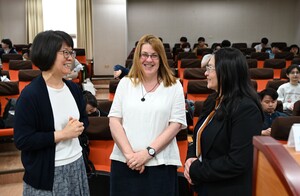
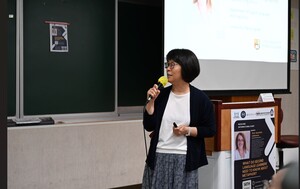
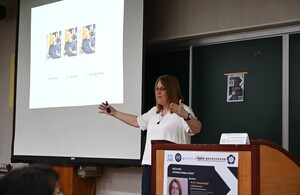
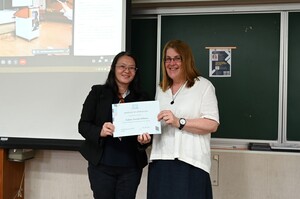
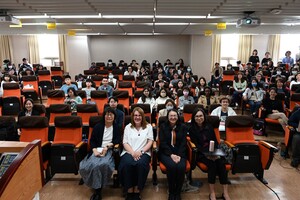
Date :
2024-05-16
Department :
EMI Resource Center
【Article by EMI Resource Center】
On the morning of May 14th, the EMI Resource Center, Department of English, and Graduate Institute of Linguistics at National Chengchi University co-hosted a physical lecture titled “What Do Second Language Learners Need to Know about Metaphor?”. This lecture was sponsored by the International Science Scholars and Experts to Taiwan for Short-term Project from the National Science and Technology Council, and our Office of Research and Development, through the application of Professor Huei-ling Lai from the Department of English. We invited internationally renowned scholar, Jeannette Littlemore, to be the keynote speaker of this talk. Professor Jeannette Littlemore is currently in the Department of English Language and Linguistics at the University of Birmingham, and serves as the Chair of the Association for Researching and Applying Metaphor. This event was opened by Professor Siaw-Fong Chung, Director of the EMI Resource Center, and the speaker was introduced by Distinguished Professor Huei-Ling Lai. The speaker’s research primarily focuses on the role of metaphor and metonymy in understanding and expressing emotional experiences, as well as exploring their impact on language learning and cross-cultural communication. More than one hundred participants attended the on-site lecture, and about thirty participants from other universities joined online.
In an era of interconnection, mastering language, especially the use of metaphor and metonymy, is quite crucial. Understanding metaphorical meanings and usage can greatly aid second language learners in academic writing. Therefore, Professor Littlemore discussed various topics related to metaphor, such as what metaphor is, how it is understood and generated, the importance of its comprehension in discourse communities, and its application in advertising.
The speaker began with a simple and understandable example, “Juliet is the sun”, to prompt attendees to think of the possible meanings behind such a sentence and quickly grasp the concept of metaphor. Metaphor, as explained, involves using vivid imagery to describe abstract concepts, adding layers of meaning to language. At the same time, metonymy, closely related to metaphor, differs in that it typically involves the substitution of one term with another in the same or related domain. For example, in the sentence “The White House has issued a statement”, the White House (the official residence and workplace of the U.S. president) is used metonymically for the U.S. government. However, distinguishing between metaphor and metonymy can sometimes be challenging.
On the other hand, understanding metaphor often entails grasping the relationship between the metaphorical source and the target domains. For second language learners, metaphors that can be explained through gestures are typically easier to understand. However, when facing those related to cultural nuances, second language learners may find them more challenging to understand. Take the term 'Conkers' as an example; it refers to a traditional British game where players use conkers threaded on strings to strike each other, and the player who breaks the opponent’s conker first is the winner. This game is filled with competitiveness and enjoyment. Therefore, when the phrase ‘Conkers in the trees’ is used metaphorically to refer to a person, it may suggest that the person is eager to accept challenges or adventures, similar to trying to break a conker in the game. This person can be understood as naive or immature.
The speaker also highlighted findings from their research, showing that learners' understanding of metaphor differs because of their Cognitive Style. Learners with Wholistic Cognitive Style tend to understand metaphorical meanings more quickly, while those with Imager Cognitive Style excel at generating creative metaphors. Additionally, learners typically consciously use their second language, which makes them more skilled at understanding the nuances of metaphors in that language. The speaker also mentioned that the use of gestures aids foreign language learners in understanding metaphors. For instance, in academic consultations, teachers often integrate gestures with metaphorical language to visualize the potential meanings of metaphors.
The generation and usage of metaphor were also key points of this lecture. Metaphors extend beyond literature into everyday discourse, including international diplomacy, shaping thoughts, and conveying complex concepts. For example, advanced English learners in Japan used novel metaphors to explain their teaching philosophies: “It is best for the students to be showered in a lot of English. But we don’t want to throw them in the water.” The speaker also stated that different proficiency level learners will apply metaphor in different forms and functions in their writing.
Furthermore, understanding of metaphor varies based on cultural and linguistic backgrounds, which emphasizes the importance of recognizing discourse communities for effective communication. Apprentices, new members of a community, require time and experience to understand the metaphors, norms, and conventions within the group, and they often learn from other members and gradually become part of the community.
Towards the end of the lecture, the speaker explained how metaphor is applied in marketing. In advertisements, the complex mappings of metaphors are often quickly understood, making the audience relate to it. Many advertisers use metaphor to enhance brand awareness, gain brand identity, and foster cross-cultural communication. However, different cultural groups may react differently to the same metaphors in advertisements, highlighting the need for advertisers to consider audience diversity when designing ads with metaphorical concepts.
Last but not least, Professor Littlemore emphasized her idea about encouraging learners to use creative metaphors and suggested that language teachers not avoid teaching more complex metaphorical concepts, for it can not simply benefit learners' language learning outcomes but help bridge comprehension gaps between languages as well.
#MORE INFORMATION:
WEBSITE:https://www.eminccu.com/
FB:https://www.facebook.com/nccu.emi/
IG:https://www.instagram.com/nccu.emi/
On the morning of May 14th, the EMI Resource Center, Department of English, and Graduate Institute of Linguistics at National Chengchi University co-hosted a physical lecture titled “What Do Second Language Learners Need to Know about Metaphor?”. This lecture was sponsored by the International Science Scholars and Experts to Taiwan for Short-term Project from the National Science and Technology Council, and our Office of Research and Development, through the application of Professor Huei-ling Lai from the Department of English. We invited internationally renowned scholar, Jeannette Littlemore, to be the keynote speaker of this talk. Professor Jeannette Littlemore is currently in the Department of English Language and Linguistics at the University of Birmingham, and serves as the Chair of the Association for Researching and Applying Metaphor. This event was opened by Professor Siaw-Fong Chung, Director of the EMI Resource Center, and the speaker was introduced by Distinguished Professor Huei-Ling Lai. The speaker’s research primarily focuses on the role of metaphor and metonymy in understanding and expressing emotional experiences, as well as exploring their impact on language learning and cross-cultural communication. More than one hundred participants attended the on-site lecture, and about thirty participants from other universities joined online.
In an era of interconnection, mastering language, especially the use of metaphor and metonymy, is quite crucial. Understanding metaphorical meanings and usage can greatly aid second language learners in academic writing. Therefore, Professor Littlemore discussed various topics related to metaphor, such as what metaphor is, how it is understood and generated, the importance of its comprehension in discourse communities, and its application in advertising.
The speaker began with a simple and understandable example, “Juliet is the sun”, to prompt attendees to think of the possible meanings behind such a sentence and quickly grasp the concept of metaphor. Metaphor, as explained, involves using vivid imagery to describe abstract concepts, adding layers of meaning to language. At the same time, metonymy, closely related to metaphor, differs in that it typically involves the substitution of one term with another in the same or related domain. For example, in the sentence “The White House has issued a statement”, the White House (the official residence and workplace of the U.S. president) is used metonymically for the U.S. government. However, distinguishing between metaphor and metonymy can sometimes be challenging.
On the other hand, understanding metaphor often entails grasping the relationship between the metaphorical source and the target domains. For second language learners, metaphors that can be explained through gestures are typically easier to understand. However, when facing those related to cultural nuances, second language learners may find them more challenging to understand. Take the term 'Conkers' as an example; it refers to a traditional British game where players use conkers threaded on strings to strike each other, and the player who breaks the opponent’s conker first is the winner. This game is filled with competitiveness and enjoyment. Therefore, when the phrase ‘Conkers in the trees’ is used metaphorically to refer to a person, it may suggest that the person is eager to accept challenges or adventures, similar to trying to break a conker in the game. This person can be understood as naive or immature.
The speaker also highlighted findings from their research, showing that learners' understanding of metaphor differs because of their Cognitive Style. Learners with Wholistic Cognitive Style tend to understand metaphorical meanings more quickly, while those with Imager Cognitive Style excel at generating creative metaphors. Additionally, learners typically consciously use their second language, which makes them more skilled at understanding the nuances of metaphors in that language. The speaker also mentioned that the use of gestures aids foreign language learners in understanding metaphors. For instance, in academic consultations, teachers often integrate gestures with metaphorical language to visualize the potential meanings of metaphors.
The generation and usage of metaphor were also key points of this lecture. Metaphors extend beyond literature into everyday discourse, including international diplomacy, shaping thoughts, and conveying complex concepts. For example, advanced English learners in Japan used novel metaphors to explain their teaching philosophies: “It is best for the students to be showered in a lot of English. But we don’t want to throw them in the water.” The speaker also stated that different proficiency level learners will apply metaphor in different forms and functions in their writing.
Furthermore, understanding of metaphor varies based on cultural and linguistic backgrounds, which emphasizes the importance of recognizing discourse communities for effective communication. Apprentices, new members of a community, require time and experience to understand the metaphors, norms, and conventions within the group, and they often learn from other members and gradually become part of the community.
Towards the end of the lecture, the speaker explained how metaphor is applied in marketing. In advertisements, the complex mappings of metaphors are often quickly understood, making the audience relate to it. Many advertisers use metaphor to enhance brand awareness, gain brand identity, and foster cross-cultural communication. However, different cultural groups may react differently to the same metaphors in advertisements, highlighting the need for advertisers to consider audience diversity when designing ads with metaphorical concepts.
Last but not least, Professor Littlemore emphasized her idea about encouraging learners to use creative metaphors and suggested that language teachers not avoid teaching more complex metaphorical concepts, for it can not simply benefit learners' language learning outcomes but help bridge comprehension gaps between languages as well.
#MORE INFORMATION:
WEBSITE:https://www.eminccu.com/
FB:https://www.facebook.com/nccu.emi/
IG:https://www.instagram.com/nccu.emi/
